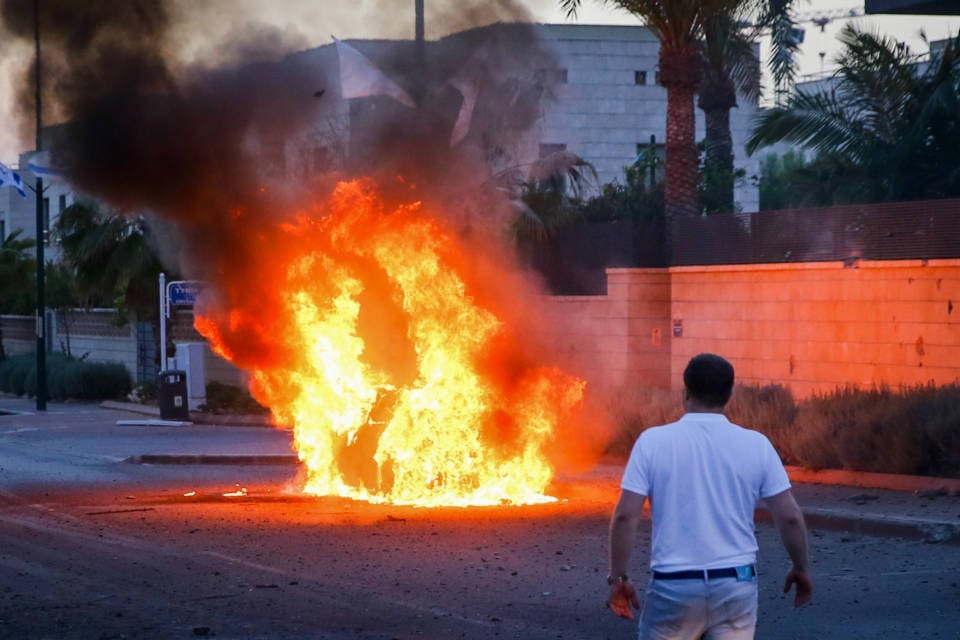The message coming from Hamas is that at least part of its leadership is prepared to stay in this deadly game until the last Iran-supplied rockets and missile are fired.
By Amir Taheri, Gatestone
The usual suspects in the Middle East peacemaking industry are already beginning to recycle their old and discredited ideas. President Joe Biden, sounding like a dummy for the ventriloquist Barack Obama, is talking of “a two-state solution: one for the Israelis and one for the Palestinians.”
The optimists forget that what turned Gaza into the hell-hole it has become wasn’t economic hardship.
Before October 7, Gaza had a lower unemployment rate than the West Bank, Jordan and Egypt. In the first two quarters of 2023, the Gaza economy grew by four percent while that of the West Bank remained almost static.
One Iranian IRGC analyst, writing in the force’s Fars News site last week, indicates that Tehran does not expect a Hamas victory but wants it to “continue fighting as long as possible” so that more and more Israelis see that the best option is to leave.
Tehran also promises to throw more of its regional assets, including the Lebanese Hezbollah, the Yemeni Houthis and various outfits in Iraq and Syria into the fray, albeit in small doses so that Iran not be dragged into the war itself.
As the war in Gaza enters its third month, the short-attention span syndrome that characterizes our age swings in full gear to reduce it to a version of background noise.
You might have noticed that the war is bowing out of front pages and dropped down several slots in TV news bulletins.
Even more interestingly we are beginning to hear growing chatter about the day-after of this tragic conflict, with the assumption that the actual fighting is heading for a close as the subtext.
The usual suspects in the Middle East peacemaking industry are already beginning to recycle their old and discredited ideas.
President Joe Biden, sounding like a dummy for the ventriloquist Barack Obama, is talking of “a two-state solution: one for the Israelis and one for the Palestinians.”
The Organisation of Islamic Cooperation is forming a multinational committee to work out a “peace formula” acceptable to both sides, not being clear about who the two sides might be.
The question isn’t academic. In some wars, those who brought the fighting to an end with a peace deal were not those who started the conflict and initially led the fighting.
Henry Kissinger’s old snake-oil diplomacy is also back in think-tanks with talk of “step-by-step” measures aimed at “confidence building” between Netanyahu and whoever masterminded Hamas’ October 7 attack on Israel.
The United Nations, now a sorry shadow of itself under a Secretary General who seems to have lost his compass, is mumbling about appointing a special emissary; perhaps Tony Blair, as suggested by some old-timers.
There is also talk, especially in Israel, of what to do with Gaza after it has been “cleansed of Hamas”.
Some talk of recolonization, that is to say reviving the Israeli settlements that were brutally dismantled by the Israeli government of Ariel Sharon in 2005.
Those engaged in such talk do not say where to find people keen on becoming settlers in the rubbish-heap that Gaza has become. And if such hot-spirited volunteers were found, would they not be concerned about facing the same fate that Sharon decreed for Israeli settlers in Gaza?
Yet another idea is to hand what is left of Gaza, when and if the war ends, to the Palestinian Authority under Mahmoud Abbas.
That might give the PA the power to liberate the 1,000 or so Fatah cadres and sympathizers that Hamas had put in prison in Gaza.
But, could the PA offer provide ruined Gaza with good governance when it has failed to do anything resembling that in the largely peaceful West Bank for more than a quarter of century?
We are also hearing talk of returning Gaza to Egyptian control, a dumb idea by any standard.
There are also ultra-optimists who are already talking of rebuilding Gaza, something which could cost more than a penny or two.
The optimists forget that what turned Gaza into the hell-hole it has become wasn’t economic hardship.
Before October 7, Gaza had a lower unemployment rate than the West Bank, Jordan and Egypt. In the first two quarters of 2023, the Gaza economy grew by four percent while that of the West Bank remained almost static.
Thanks to generous donations by UNRWA, the European Union, Qatar, the Palestinian Authority, repatriated income by some 100,000 Gazans working abroad, including 25,000 working in Israel, and customs revenue from Israeli governments, Gaza had 36 hospitals and 3,500 hospital beds, figures that are per capita higher than those of Egypt and Jordan.
Thanks to international aid and donations by wealthy Palestinians in Europe and the Americas, Gaza ranked ahead of the Islamic Republic of Iran as percentage of GDP allocated to health and education.
At the same time, Hamas did not need to fund its military and the tunnels it dug through taxation, as Tehran covered much of the cost.
The classical causes of war over land, access to natural resources including water and/or markets do not apply to Gaza.
In normal wars, if one is allowed to speak of such an obnoxious concept, the belligerents want something tangible that either side could accept when the cost-benefit calculation turns in favor of peace.
But the war in Gaza isn’t a normal one. Hamas wants something that Israel cannot deliver, i.e. the total destruction of Israel “from the river to the sea.”
Israel, too, wants something that Hamas cannot accept: ideological suicide, by accepting to lord it over in Gaza in relative comfort and forgetting about “the cause,” which is wiping Israel off the map.
If Hamas were to accept such a deal, it would end up as a perhaps more colorful version of Fatah. Thus, trying to remove those imaginary causes is at best an exercise in futility.
All those considerations, however, could be left aside so that we could focus on shortening the current killing spree.
The Islamic Republic of Iran clearly wants the killing spree to continue, albeit in the form of what an Islamic Revolutionary Guard Corps analysts now describe as “low intensity war.”
One IRGC analyst, writing in the force’s Fars News site last week, indicates that Tehran does not expect a Hamas victory but wants it to “continue fighting as long as possible” so that more and more Israelis see that the best option is to leave.
Tehran also promises to throw more of its regional assets, including the Lebanese Hezbollah, the Yemeni Houthis and various outfits in Iraq and Syria into the fray, albeit in small doses so that Iran not be dragged into the war itself.
The idea is that the longer the fighting lasts, the bigger the damage done to Israel’s image both at home and in the world at large.
In other words: if you can’t win on the battlefield, try to win the propaganda war.
The message coming from Hamas is that at least part of its leadership is prepared to stay in this deadly game until the last Iran-supplied rockets and missile are fired.
Will Israel too, try to adjust its strategy for a long low-intensity war as a sequel to the classical “big hammer” one that may have already achieved its initial aims?
Israel at War with Hamas. Support Israel Today!
The people of Israel need your help at this most critical time. Please make a donation to help protect and defend Israelis against unprecedented Hamas terror.
Rockets are falling. Sirens blare, with seconds to run for cover. IDF soldiers risk their lives battling terrorists inside Gaza. Thousands forced to abandon their homes in southern Israel.
To fight terror and save lives, UWI provides bomb shelters, anti-terror vehicles, protective gear, security equipment, medical assistance, relief to victims and much more. Help Israel fight and win this war against Hamas. The time to act is now!




